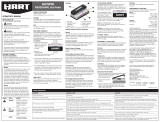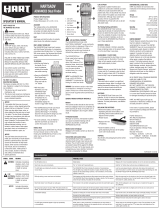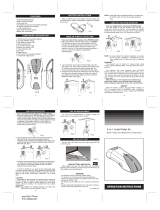2 modos de escaneo:
• StudScan localiza los bordes de las vigas de madera y metal
hasta una profundidad de
3
⁄4" (19 mm)
• DeepScan localiza los bordes de las vigas de madera y metal
hasta una profundidad de 1
1
⁄2" (38 mm)
Detección WireWarning automáticamente detecta y alerta
al usuario sobre cableado AC* activo (corriente alterna)
en los ambos modos. Cuando se detecte voltaje de cableado
AC* activo, el Indicador de Detección WireWarning encenderá
en la pantalla.
INSTALAR BATERÍA DE 9 VOLTIOS
Siempre utilice una nueva batería alcalina
de 9V con una fecha de vencimiento
extendida superior a 3 años. Haga
coincidir las direcciones de la batería con
la imagen dentro del compartimento
de la batería.
ADVERTENCIA
No confíe exclusivamente en el
detector para localizar objetos
detrás de la superficie. Utilice otras fuentes de
información para ayudarse a localizar los artículos
antes de atravesar la superficie, incluyendo
los planes de construcción, los puntos visibles
de entrada de los tubos y cables en las paredes,
como en un sótano, y en separaciones estándar
entre las vigas.
DETECCIÓN WIREWARNING
La Detección WireWarning de Zircon
®
trabaja continuamente en ambos
modos. Cuando se detecta voltaje de
cableado AC* activo con corriente
sin blindaje, se muestra el Indicador
de Detección WireWarning. Si el
escaneo comienza sobre un cableado
AC* activo, el Indicador parpadeará
continuamente. (Figura F)
Tenga extrema precaución bajo estas
circunstancias, o siempre que haya cableado AC* activo.
ADVERTENCIA
ES POSIBLE QUE EL DETECTOR
NO DETECTE CORRIENTE ACTIVA
SI LOS CABLES ESTÁN A MÁS DE 2" (50 mm) DEBAJO
DE LA SUPERFICIE ESCANEADA, EN CONCRETO, EN UN
TUBO, DETRÁS DE UN MURO O PAREDES METÁLICAS,
O SI HAY HUMEDAD EN EL AMBIENTE O EN LA
SUPERFICIE ESCANEADA.
TRABAJAR CON DIFERENTES MATERIALES
Papel tapiz Este detector funciona normalmente en paredes
cubiertas con papel tapiz o tela, a menos que los materiales
tengan láminas metálicas, contengan fibras metálicas o estén
aún húmedos después de haber sido aplicados. Es posible que
el papel tapiz necesite varias semanas para secarse totalmente
después de ser aplicado.
Paredes recién pintadas Puede tardar una semana o más
para secarse después de la aplicación.
Listones y yesos Debido a las irregularidades en el espesor
del yeso, este detector no es recomendado para usarse en
listones y yesos.
Paredes muy texturizadas o techos acústicos Al escanear
un techo o pared con una superficie poco uniforme, coloque
un cartón delgado en la superficie que va a escanear y escanee
sobre el cartón en el modo DeepScan.
Pisos de madera, contrapiso o panel de yeso sobre
revestimiento de contrachapado Utilice el modo DeepScan
y mueva el detector lentamente.
Este detector no puede detectar vigas o viguetas a través
de alfombras y almohadillas.
NOTA: La profundidad y precisión de detección pueden
variar dependiendo de las condiciones ambientales
del escaneo, como el contenido mineral, la humedad,
la textura y consistencia de las paredes.
ENCENDER
Mueva el Interruptor Selector de Modo al modo deseado:
StudScan o DeepScan.
Para activar el detector, mantenga presionado el Botón
de Encendido. Si el botón no se mantiene presionado,
la unidad se apagará.
LOCALIZAR UNA VIGA
Este detector está diseñado para
localizar los bordes de la viga de
madera y metal hasta
3
⁄4" (19 mm)
de profundidad debajo de la
superficie escaneada en el
modo StudScan. La precisión lateral
de la viga detectada es normalmente
dentro de
1
⁄8" (3 mm).
Para obtener mejores resultados,
sostenga el detector como se muestra
en (Figura A) y muévalo lentamente
al escanear. No toque
la superficie durante la
calibración o escaneo.
1. Sostenga el detector plano contra
la pared, luego mantenga presionado
el Botón de Encendido. En 1–2
segundos, la unidad se calibrará,
y la luz verde READY se iluminará.
NO MUEVA EL DETECTOR
DURANTE LA CALIBRACIÓN.
2. Con el Botón de Encendido
presionado, deslice el detector
lentamente por la pared. (Figura B)
3. Cuando el detector llegue
al borde de la viga, se encenderá
la luz roja EDGE de arriba,
el Apuntador SpotLite brillará,
y sonará un tono constante.
Marque el punto. (Figura C)
4. Sin soltar el Botón de Encendido,
continúe con la dirección de escaneo
hasta que las luces rojas EDGE y
el Apuntador SpotLite se apaguen,
luego invierta la dirección. (Figura D)
5. Deslice el detector hasta que
se detecte el otro borde de la viga
y marque esto también. (Figura E)
El centro de la viga es el punto medio
entre las dos marcas.
MODO DE DEEPSCAN
El modo DeepScan detectará las vigas hasta 1
1
⁄2" (38 mm)
de profundidad, o el doble de la profundidad de StudScan.
Cambie al modo DeepScan, luego siga los pasos 2–5 bajo
LOCALIZAR UNA VIGA.
ADVERTENCIA
NO ASUMA QUE NO HAY
CABLES ELÉCTRICOS CON
CORRIENTE EN LA PARED. NO TOME MEDIDAS QUE
PUEDAN SER PELIGROSAS SI LA PARED CONTIENE
UN CABLE ELÉCTRICO CON CORRIENTE. SIEMPRE
APAGUE LA ELECTRICIDAD Y DESCONECTE GAS,
Y FUENTES DE AGUA ANTES DE ATRAVESAR UNA
SUPERFICIE. EL INCUMPLIMIENTO DE ESTAS
INSTRUCCIONES PODRÍA PROVOCAR UNA
DESCARGA ELÉCTRICA, FUEGO, Y/O LESIONES
GRAVES O DAÑOS A LA PROPIEDAD.
Cableado eléctrico y tuberías Dependiendo de la proximidad
de conexiones eléctricas o tuberías a la superficie de la pared,
el detector puede detectarlos de la misma manera que las vigas.
Es necesario tener precaución siempre al clavar, cortar o
taladrar en paredes, pisos y cielorrasos que puedan contener
estos elementos.
Las vigas y viguetas suelen tener una separación de 16 ó
24" (40 ó 60 cm) y un ancho de 1
1
⁄2" (38 mm). Todo lo que no
esté instalado a esa separación o que sea de un ancho diferente
puede no ser una viga o vigueta.
Este detector no está diseñado para utilizarse con:
• Azulejo de cerámica, pizarra, granito, mármol y otras
superficies de roca
• Alfombras y acolchado de alfombra
• Papel tapiz con fibras metálicas
• Paredes recién pintadas que aun estén húmedas (puede tardar
una semana o más para secarse después de la aplicación)
• Paredes de listón y yeso
• Tablero de aislamiento cubierto con hoja metálica
• Vidrio/cristal o cualquier material denso
• Inserciones de bãno como bañeras y duchas
• Superficies más gruesas que
3
⁄4" (19 mm)
*AC: Se refiere cables con corriente alterna (CA).
GARANTÍA LIMITADA DE 1 AÑO
El Corporativo Zircon (“Zircon”) garantiza al cliente que
este producto se encuentra libre de defectos en sus
materiales y mano de obra por un periodo de un año
a partir de la fecha de su compra. Cualquier producto
defectuoso devuelto a Zircon dentro del periodo
de garantía a la dirección indicada abajo, con flete
prepagado y comprobante de la compra, será reparado
o reemplazado a discreción de Zircon. La reparación
o reemplazo puede hacerse con un producto y
componentes nuevos o restaurados a discreción de
Zircon. Si el producto devuelto ya no está disponible,
Zircon puede sustituir el producto por un producto similar
en base a su funcionamiento. Esta garantía se limita a los
circuitos electrónicos del producto y a su carcasa original,
y específicamente excluye cualquier daño causado por
abuso, modificación, manejo contrario de uso de estas
instrucciones, otro uso no razonable o negligencia.
Este es su único y exclusivo recurso para el
incumplimiento de esta Garantía Limitada.
Esta garantía limitada es una parte de otras garantías,
expresas o implícitas y Zircon no será responsable por
ninguna otra afirmación o reclamo de naturaleza similar.
Toda garantía implícita que se aplique a este producto
está limitada a un periodo de un año a partir de la fecha
de su compra. Esta garantía limitada no cubre las piezas
consumibles, incluidas como las baterías o el software,
incluso si están empaquetadas con el producto.
EN NINGÚN CASO ZIRCON SERÁ RESPONSABLE POR
CUALQUIER DAÑO ESPECIAL, INCIDENTAL O COMO
CONSECUENCIA DE LA POSESIÓN, USO O EL MAL
FUNCIONAMIENTO DE ESTE PRODUCTO.
Algunos estados no permiten limitaciones en cuanto
al periodo de duración de una garantía implícita y/o
a la exclusión o a la limitación de daños secundarios
o consecuentes, de modo que las limitaciones y/o
exclusiones mencionadas anteriormente pueden no ser
aplicables en su caso. Esta garantía le otorga derechos
legales específicos, y Usted también podría tener otros
derechos que pueden variar de estado a estado.
Envíe el producto con flete prepagado y el comprobante
con la fecha de compra (recibo de ventas con fecha) a:
Zircon Corporation
Attn: Returns Department
1580 Dell Avenue
Campbell, CA 95008-6992 USA
Asegúrese de incluir su nombre y dirección para la
devolución. Permita de 4 a 6 semanas para la entrega.
Atención al Cliente, 1-800-245-9265 ó 1-408-963-4550
Lunes a Viernes, 8:00 a.m. a 5:00 p.m. Hora Estándar
del Pacífico
©2018 Zircon Corporation • P/N
66308
• Rev C 11/18
DeepScan, SpotLite
, StudSensor
, WireWarning,
y Zircon son marcas de fábrica o marcas registradas
de Zircon Corporation.
ANTES DE EMPEZAR
LOS DETECTORES DE VIGAS ZIRCON
®
FUNCIONAN AL DETECTAR CAMBIOS DE DENSIDAD DETRÁS DE LA PARED. SE PUEDEN DETECTAR OTROS
OBJETOS – ESPECIALMENTE SI ESTÁN MUY CERCA DE LA PARED. NO SUPONGA QUE TODO LO DETECTADO ES UNA VIGA.
- Siempre utilice una nueva batería alcalina de 9V con una fecha de vencimiento extendida superior a 3 años. Haga coincidir las direcciones de la
batería con la imagen dentro del compartimento de la batería.
- No confíe exclusivamente en el detector para localizar objetos detrás de la superficie. Utilice información adicional para ayudar a localizar los objetos
antes de penetrar la superficie. La información incluye planos de construcción, puntos visibles de entrada de las tuberías y el cableado en las paredes,
como en un sótano, y las separaciones estándar entre las vigas.
- Siempre inicie su escaneo en el modo StudScan el cual escanea superficies de hasta
3
⁄4" (19 mm) de profundidad. El modo DeepScan
®
puede detectar
objetos lejanos detrás de la pared que pueda o no ser una viga.
- Siempre escanee vigas a diferentes alturas de la pared y marque la ubicación de cada objeto detectado. Esto se llama “mapeo de la pared.”
Las tuberías y otros objetos probablemente no den lecturas consistentes desde el piso hasta el techo, como lo haría una viga.
- Las lecturas siempre deben ser consistentes y repetibles.
- Los detectores de vigas Zircon son recomendados sólo para el uso interior.
- Las vigas normalmente están colocadas verticalmente desde el piso hacia el techo, excepto arriba y debajo de las ventanas, y arriba de las puertas.
- Otros objetos comunes en paredes, pisos o techos son tuberías de agua, líneas de gas, barrera cortafuego, y cableado eléctrico.
- La profundidad y precisión de detección pueden variar dependiendo de las condiciones ambientales del escaneo, como el contenido mineral,
la humedad, la textura y consistencia de las paredes.
- Siempre apague la electricidad cuando trabaje cerca de cables eléctricos.
- Dependiendo de la proximidad de conexiones eléctricas o tuberías a la superficie de la pared, el detector puede detectarlos de la misma manera
que las vigas. Es necesario tener precaución siempre al clavar, cortar o taladrar en paredes, pisos y cielorrasos que puedan contener estos elementos.
- Las vigas y viguetas suelen tener una separación de 16 ó 24" (40 ó 60 cm), un ancho de tienen 1
1
⁄2" (38 mm), y quizás estén separadas por
barrera cortafuego. Todo lo que no esté instalado a esa separación o que sea de un ancho diferente puede que no sea una viga o vigueta.
StudSensor
™
L40
Detector de Bordes de Vigas
ES
Visite www.zircon.com para las
instrucciones más actualizadas.
Advertencia de Registro de la Parte 15 del FCC Clase B: Este aparato
cumple con las reglas Parte 15 de la FCC. Su operación está sujeta
a las siguientes dos condiciones: (1) este aparato no puede causar
interferencia dañina, y (2) este aparato debe aceptar cualquier
interferencia recibida, incluyendo la interferencia que pueda causar
la operación no deseada.
ZirconCorporation ZirconTV
ZirconTools
|
ZirconToolPro
ZirconTools
Figura C
Figura D
Figura B
CONSEJOS ÚTILES & CONSEJOS PARA CONSTRUCCIÓN
SITUACIÓN CAUSAS PROBABLES SOLUCIONES
Todos los elementos de
la pantalla se encienden
al mismo tiempo y
el detector emite un
tono continuo.
El detector podría no esta plano
contra la pared.
• Sostenga el detector con su pulgar en un lado y sus dedos en el otro. No toque la superficie
que se está escaneando o el cabezal del detector.
• Mueva el detector de manera rectilínea hacia arriba y hacia abajo, paralela a las vigas.
No gire el detector.
El detector se inclinó o levantó
durante el escaneo.
• Al escanear una superficie poco uniforme, coloque un cartón delgado en la superficie que va
a escanear y escanee sobre el cartón en el modo DeepScan.
• Mueva el Interruptor de Modo para cambiar al modo DeepScan.
La superficie de escaneo es muy
denso o está muy húmedo para
que funcione el detector.
Si el detector está usado sobre una superficie que está recién tapada, pintada o empapelada,
deje suficiente tiempo para secarse y vuelva a intentar escanear de nuevo.
El Botón de Encendido fue
presionado antes de colocar
el detector en la superficie.
Coloque el detector sobre la pared, luego presione el Botón de Encendido, y espere que
la unidad se calibre antes de escaneo.
No detecta vigas en
el modo StudScan–
la flecha EDGE de arriba
no se enciende.
La pared es gruesa o densa.
• Cambie al modo DeepScan para localizar la viga.
• Use la flecha EDGE de arriba como la indicación del borde de la viga.
Se enciende la luz verde
READY, pero no hace nada
durante el escaneo.
Puede que el detector no esté
colocado plano contra la pared.
Sostenga el detector de modo que la parte posterior hagan contacto completo con la superficie.
Puede que el detector haya sido
calibrado sobre una viga en
el modo DeepScan.
Vuelva a calibrar en un área diferente, luego continúe el escaneo.
No detecta vigas en el
modo DeepScan.
Puede que el detector haya sido
calibrado sobre una viga.
Mueva la unidad a un área diferente, luego vuelva a escanear. También asegúrese de sujetar
el detector contra la pared como se muestra en las ilustraciones.
El detector no detecta otro
objetos además de vigas
o encuentra más vigas de
las que debería estar allí.
El cableado eléctrico y los tubos de
metal/plástico pueden estar cerca
o tocando la superficie posterior
de la pared.
Verifique que no haya otras vigas espaciadas en ambos lados a intervalos de 12, 16 ó 24" (30,
40 ó 60 cm), o revise la misma viga en las zonas directamente por encima o por debajo de
la primera área de escaneo. Las vigas están colocadas en forma rectilínea hacia arriba y hacia
abajo, del piso hacia el techo, mientras que la tubería puede cambiar de dirección. Las vigas
estándar miden aproximadamente 1
1
⁄2
" (38 mm) entre los bordes. Cualquier cosa más grande o
más pequeña es probable que no sea una viga (a menos que esté cerca de la puerta o ventana).
El área de detección
del voltaje es
demasiado grande.
La detección del voltaje puede
extenderse en el panel de yeso
tanto como 12" (30 cm) en cada
lado del cableado.
Reduzca la detección de escaneo: 1. Apague el detector. 2. Enciéndalo de nuevo en el borde
donde se detectó el cable por primera vez. 3. Repita el escaneo.
Se sospecha que hay
dables eléctricos, pero la
Detección WireWarning
®
no alerta.
Los cables pueden estar protegidos
dentro de conductos de metal,
una capa de alambre trenzada, o
revestimiento metálico de la pared.
Si hay un interruptor de tomacorriente, asegúrese de que esté ENCENDIDO mientras esté
realizando el escaneo, pero apáguelo cuando trabaje cerca de los cables eléctricos.
Tenga especial cuidado si el área tiene madera contrachapada, madera gruesa
de soporte detrás de paneles de yeso o paredes que son más gruesas de lo normal.
Los cables ubicados a mayor
profundidad de 2" (50 mm) de
la superficie es posible que no se
puedan detectar.
Véase más arriba.
Puede que los cables no
estén activos.
Enchufe una lámpara en el tomacorriente y enciéndala para comprobar si los cables eléctricos
están activos.
Figure A
Figura E
Figure F
Apuntador SpotLite
®
Muesca para Marcación
Lengüeta de Tapa
de Batería (en la
parte porterior)
Indicador de Detección
WireWarning
®
Mango Ergonómico
Botón de Encendido
Luz roja EDGE
(indicadora de borde)
Luz verde READY
(indicadora de
encendido)
Selector de Modo
Indicador
de modo
DeepScan
®
Indicador de
modo StudScan


 1
1
 2
2
Zircon 70335 User manual
Zircon 73190 Wood Stud SuperScan Advanced Stud Finder User manual
Zircon Pro SL User manual
Zircon 66229 Installation guide
Zircon 71675 Installation guide
Zircon 70335 Operating instructions
Zircon SL-AC User manual
Zircon MultiScanner i520 OneStep User manual
Zircon ONESTEP I65 User manual
Zircon 68882 User manual
Eclipse 902-592 Owner's manual
Fuller ST200 Operating instructions
 HART HART9PRO Owner's manual
HART HART9PRO Owner's manual
 HART HART5ADV Owner's manual
HART HART5ADV Owner's manual
UNI-T UT387C Stud Sensor Wall Scanner User manual
Workzone 11334 User manual
Aktakom ACT-1210 User manual
 Pittsburgh 92375 Owner's manual
Pittsburgh 92375 Owner's manual
Bosch Power Tools Multi-Detector DMD4 User manual
 HiB Zircon Datasheet
HiB Zircon Datasheet





